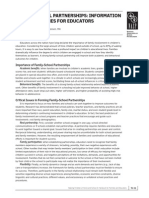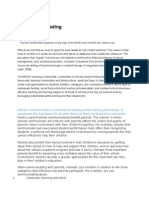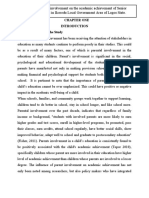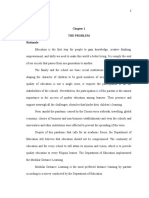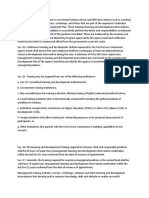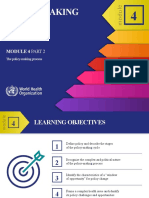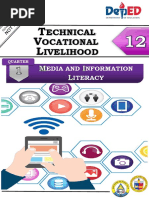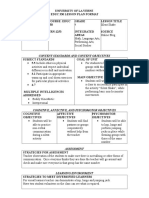Urgent Message: Families Crucial To School Reform: Anne Henderson
Urgent Message: Families Crucial To School Reform: Anne Henderson
Uploaded by
Lunar WalkerCopyright:
Available Formats
Urgent Message: Families Crucial To School Reform: Anne Henderson
Urgent Message: Families Crucial To School Reform: Anne Henderson
Uploaded by
Lunar WalkerOriginal Title
Copyright
Available Formats
Share this document
Did you find this document useful?
Is this content inappropriate?
Copyright:
Available Formats
Urgent Message: Families Crucial To School Reform: Anne Henderson
Urgent Message: Families Crucial To School Reform: Anne Henderson
Uploaded by
Lunar WalkerCopyright:
Available Formats
Urgent Message:
Families Crucial to School Reform
Anne Henderson
T
he vision of higher standards to be achieved by every student is the most
ambitious challenge American public education hasever faced. For the first
time in our history, the nation has adopted policies that promise all students—
rich and poor, no matter where they live, the language of their family, or how long
it takes them to learn—a quality education.
We know how to create a quality educational environment for all children, teach-
ers, and parents. Participants at a 1997 national conference on advancing family
and parental involvement in school reform agreed the following are required:
• Families, schools, and communities working together for children.
• Accountability measures that hold everyone responsible for improving stu-
dent achievement.
• Strategies that increase the capacities of educators, families, and
students to teach and learn to high standards.
In schools that try to embody these characteristics, neither the schools nor par-
ents working alone can help children make noticeable progress. Quality education
for all comes about through informed, focused, and collaborative efforts by edu-
cators, students, and parents who hold high expectations for themselves.
Unfortunately, such schools exist in only a few places. As a result, parents who
can afford to are seriously considering opting out of traditional public schools be-
cause they can’t sacrifice their children to such slow change. About 44% of par-
ents responding to the 1997 Phi Delta Kappa/Gallup Poll approved of letting par-
ents choose a private school at public expense. Three years earlier, only 24% ap-
proved of the idea.
Even the most ardent believers in raising standards for schools and students
worry about how long it is taking to move to a public school system committed to
the success of every child. The slow pace of change allows critics of public edu-
cation to press for more radical changes that could undermine support of public
education even further.
The greatest failures of all
The children of the poor are most affected by the failure of reforms to generate
the improvement they promised. According to the Education Trust (1996), high-
poverty schools have more unqualified teachers, offer fewer college prep
courses, lack instructional resources, and have lower achievement scores. When
20 Urgent Message: Families Crucial to School Reform
students, no matter their color or family income level, have access to rigorous
math and science courses, they score higher on such tests as the SAT and ACT.
Reports show a consistent gap between the performance of White students and
that of African American and Hispanic students. However, they do not report in
detail on the differences in opportunities that students in low-resource schools ex-
perience every day. The impression left is that poor children just can’t do the
work. In truth, the opportunities to do the work generally are not available. A fundamental flaw
of the reform move-
Early interventions with failing students are critical, but our concerns are much
broader and deeper. Assuring academic success begins with restructuring the ba-
ment is that parents
sic experiences of students in classrooms. Reducing the failure of reform efforts are not included in
to lack of money or improper teacher assignments diverts attention from the meaningful ways.
overall need to change the learning environment significantly.
The serious neglect of parents in reform efforts
A fundamental flaw of the reform movement is that parents are not
included in meaningful ways.
In some communities, a few parents serve on the task forces and committees or-
ganized to plan changes. In some places they are at the table when important de-
cisions about staffing and resources are made. They may be invited to come to
schools to hear about what standards mean or learn about new kinds of assess-
ments.
Yet, in most communities parents generally are neither involved nor well in-
formed. Because they are not included in significant planning, parents are left to
concern themselves with peripheral issues such as worrying about the use of cal-
culators or the time spent in noisy group work. Without chances to engage in
more thoughtful conversations, parents have limited knowledge about standards,
for example, or how critical thinking helps students learn basic skills. As a result,
many parents are unsure of, even alienated from, what is happening under the la-
bel of school reform.
Despite national and state flurries of attention to greater parent involvement as
part of the reform movement, families are most often considered adjuncts to the
intellectual work of the school. Parents need to listen, school people seem to say,
rather than be listened to. Schools are more interested in teaching parenting skills
than in learning the insights parents have about their children.
A recent Public Agenda (1993) survey found
• 60% of Americans believed parents and the community should
have more say in basic decisions within schools,
• only 25% of teachers approved of greater parental inclusion in
decisions, and
• less than 15% of administrators thought it was a good idea.
Wisconsin Family Impact Seminars 21
However, studies show that parental involvement is crucial to the success of re-
forms. That is why the typical kinds of parent involvement need restructuring,
too, so that when schools and parents do have opportunities to come together, the
conversations and decisions will be meaningful and important. They should be
talking about visions and school improvement as well as about PTA dues and
field trips.
The parent factor in student achievement
It is common sense that parents’ interest in and support of their children’s learn-
ing at home results in higher achievement at school. The research shows when
parents have many different kinds of opportunities to be involved in the school,
their children go further in school and the schools they attend get better results.
In a review of the research, Henderson and Berla (1994) found that the children
who are furthest behind make the greatest gains in achievement when their par-
ents are part of school life. When parents understand the purposes and expected
outcomes of standards-based reforms, they will be even more able to support at
home what teachers and administrators are committed to at school.
Henderson and Berla (1994) found these benefits for students when schools sup-
port families’ engagement in their children’s learning at home and at school:
• Higher grades and test scores.
• Better attendance and more homework done.
• Fewer placements in special education.
• More positive attitudes and behavior.
• Higher graduation rates.
• Greater enrollment in postsecondary education.
The benefits extend to families, too. Parents develop more confidence in the
school. The teachers of their children have higher opinions of them as parents
and higher expectations of their children. As a result, parents develop more confi-
dence, not only in helping their children learn, but also in themselves as parents.
Often, the involvement encourages parents to seek more education.
The children who are There are three primary ways parents contribute to moving schools toward qual-
furthest behind make ity standards and higher student achievement. These are pushing the system,
helping design local school improvement, and taking part in the parent involve-
the greatest gains in
ment opportunities created by the reforms.
achievement when
their parents are part Pushing the system
of school life. Parents need to press for higher standards and a fair, effective system of ac-
countability. They must insist on high-quality public schools and press their local
school to adopt school reform. If traditional schools are failing, they should create
22 Urgent Message: Families Crucial to School Reform
alternative public schools. Where parents push the system, improvements result.
• In Kentucky, 20,000 parents gathered at local meetings to create a
vision that resulted in the Kentucky Education Reform Act, one of the most
comprehensive in the country.
• In an El Paso elementary school, where 90% of the students come from
homes where Spanish is spoken, a community organization set up account-
ability sessions at the school. After 2 years, 70% of students now pass the
state reading test.
Parents should
• At the almost all African American Slowe School in Washington, D.C., par-
ents now sit on all school improvement committees, and student test scores monitor reform
are 20 to 30 points above the national averages on standardized tests. results and ask
the hard questions.
• In Brooklyn, activist parents chose a new principal who supported creating
alternatives to the large, institutional schools where their children were not
doing well academically. The school now is a campus of four small alterna-
tive schools, each run by a teacher-director and a steering committee of
parents and teachers. Student test scores have climbed steadily.
Helping design local school improvement
Parents should participate in school improvement committees to design and
implement reforms. They should monitor results and ask the hard questions. They
should check student work to make sure it reflects high standards and high per-
formance. They should insist on report cards designed so parents can see how
their students are progressing. This kind of involvement shows results:
• In Louisville, parents and teachers revamped the school’s Title I program,
bringing in Reading Recovery to the primary grades and insisting that all
children learn to read by the end of third grade. Test scores are up 50% in 4
years.
• Norwood Park School in Chicago identified a 57% mobility rate
as a barrier and held community discussions to find ways to keep families in
the school. In response, the school added an all-day
kindergarten program and built strong relationships with families. Mobility
went down to 8% in 3 years. Achievement scores are up
almost 50%.
• At Ysleta Elementary School in El Paso, the school standards
team of teachers, the principal, support staff, and parents wrote scoring
guides so that students, teachers, and parents alike could recognize high-
and low-quality student work. Students use the scoring guides to rate their
work and explain it to each other and
to their parents.
Wisconsin Family Impact Seminars 23
• In a Kentucky school, parents worked with teachers to design a new report
card that lists the state’s learning goals for each subject so parents can un-
derstand their children’s scores.
Taking part in the parent involvement opportunities created by the reforms
Parents should participate in school governance councils that set policy, develop
new programs, and decide how to address low student achievement. They should
encourage other parents to become actively engaged in the school. They can
help obtain resources to improve the school. And they should attend staff devel-
opment sessions. These actions produce results:
• At a Los Angeles school, members of the school governance council, half
of whom are parents, created a 200-day, year-round academic program and
reduced class size to 20 students for each teacher in grades 1–3. The coun-
cil also designed a family center, a one-stop shop for social services, and a
career ladder program for parents.
• In a Boston elementary school, more than 25% of children have significant
disabilities requiring supplemental and supportive services. Parents created
a family center and a parent outreach program. They offer workshops
about standards-based education and how children’s programs can be modi-
fied to enable them to meet the expected standards. They also offer lan-
guage instruction, organize ways for parents to help out in classrooms, and
provide opportunities for networking.
• At a high school in rural Tennessee, parents rallied to save their school after
the county decided not to renovate the 50-year-old building. The school is
now an agricultural service center where students offer services such as
equipment repair and cattle weighing. Local family farming businesses pro-
vide opportunities for students to learn math, science, social studies, and
writing skills.
• In New York City, many new, small schools have been organized around the
city and offer help to other parents, teachers, and students interested in
forming smaller schools.
• In Texas, more than 600 teachers and parents have attended
conferences on school reforms.
For school reforms to bring about success for all students, efforts such as those
described above must multiply by the thousands. Whenever reform efforts
reached a peak in the past, researcher Richard Elmore points out, those commit-
ted to change usually were gathered up and concentrated in one place. The isola-
tion of these reforms meant that their innovation withered away. As some of the
examples cited above demonstrate, parents often need outside help to organize
their attempts to get reforms that have staying power and significantly change
the learning environment for their children.
24 Urgent Message: Families Crucial to School Reform
We do not underestimate the challenge of building respect between educators
and parents so they can work together on needed reforms. However, we are
concerned that time is short. We must demonstrate that higher standards and
other reforms can take hold in public education programs serving all children, in-
cluding those from low-income families and those with significant disabilities.
Critics of public education have launched well-funded efforts to turn parents’ dis-
illusionment with schools into a reason for abandoning public education altogether. Policymakers and
Policymakers and taxpayers who see little progress may withdraw their support taxpayers who see
for public education. little progress may
The public school reform movement cannot go much further without the kind of withdraw their
parent involvement and support called for in this report. Our message about support for public
transforming public schools is urgent. It must be done, done right, and done education.
quickly.
What ALL Parents Should Know and
Be Able to Do About School Reform
• Participate in creating a vision for the school that sets high
expectations for all.
• Take part in developing a system to report on student progress
and participate in holding the schools accountable for the results.
• Be involved in monitoring and analyzing data on student
achievement.
• Be involved in decisions that affect their children’s opportunities
to learn, such as how resources are used, what the learning
objectives are, and what instructional strategies ought to be
used to accommodate individual differences.
• Know what needs to change in teaching and learning to ensure
their children learn well.
• Know what their children should be learning and know it well
enough to ask good questions.
• Accept responsibility for providing support at home that will
help their children learn to high expectations.
• Understand their children’s rights to receive a high-quality
education and their own rights to be involved—and be vigilant
about exercising those rights.
• Know how to find and use outside help when their children are
not receiving the kind of education that will enable them to meet
high standards.
Wisconsin Family Impact Seminars 25
References
The Education Trust. (1996). Education watch: The 1996 state and national data book and
the community data guide, Washington, DC: Author.
Henderson, A. T., & Berla, N. (1994). A new generation of evidence: The family is critical
to student achievement. Washington, DC: Center for Law and Education.
Public Agenda Foundation. (1993). Divided within, besieged without: The politics of edu-
cation in four American school districts. New York: Author.
26 Urgent Message: Families Crucial to School Reform
You might also like
- Families and Educators Together: Building Great Relationships that Support Young ChildrenFrom EverandFamilies and Educators Together: Building Great Relationships that Support Young ChildrenNo ratings yet
- 1991 SeaWorld Permit Application For Sealand Killer Whales (No. 775)No ratings yet1991 SeaWorld Permit Application For Sealand Killer Whales (No. 775)64 pages
- The Parent-Teacher Partnership: How to Work Together for Student AchievementFrom EverandThe Parent-Teacher Partnership: How to Work Together for Student Achievement4.5/5 (3)
- (Diploma in Hotel Management) BPP Learning Media - CTH Front Office Operations-BPP Learning Media (2009)100% (1)(Diploma in Hotel Management) BPP Learning Media - CTH Front Office Operations-BPP Learning Media (2009)321 pages
- Improving Family and Community Involvement in Secondary SchoolsNo ratings yetImproving Family and Community Involvement in Secondary Schools5 pages
- 2.1 The Benefits of Parent Involvement: What Research Has To SayNo ratings yet2.1 The Benefits of Parent Involvement: What Research Has To Say3 pages
- Parental Involvement Study For Reference OnlyNo ratings yetParental Involvement Study For Reference Only47 pages
- IJESR - School Practices in Parental Involvement PDFNo ratings yetIJESR - School Practices in Parental Involvement PDF20 pages
- Nea - Research Spotlight On Parental Involvement in EducationNo ratings yetNea - Research Spotlight On Parental Involvement in Education2 pages
- Awareness and Participation of Parents Towards School Programs/Activities in Angadanan National High SchoolNo ratings yetAwareness and Participation of Parents Towards School Programs/Activities in Angadanan National High School60 pages
- Collaborative Family-School Relationships For Children's LearningNo ratings yetCollaborative Family-School Relationships For Children's Learning56 pages
- The Benefits of Parent Involvement: What Research Has To SayNo ratings yetThe Benefits of Parent Involvement: What Research Has To Say1 page
- Final Parent Involvement Fact Sheet 14732 7No ratings yetFinal Parent Involvement Fact Sheet 14732 74 pages
- Parental Involvement To Their Child's Achievement Chapter 1 and 3No ratings yetParental Involvement To Their Child's Achievement Chapter 1 and 315 pages
- Parental Involvement As A Important Factor ForNo ratings yetParental Involvement As A Important Factor For13 pages
- The Power of Parent InvolvementEvidenceIdeas and Tools For Student SuccessNo ratings yetThe Power of Parent InvolvementEvidenceIdeas and Tools For Student Success13 pages
- Thomas Dominique Updatedexpositoryessay Orginal DraftNo ratings yetThomas Dominique Updatedexpositoryessay Orginal Draft5 pages
- Parent Involvement and Community Partnership: Doris J. Yu School Head, Tnhs100% (2)Parent Involvement and Community Partnership: Doris J. Yu School Head, Tnhs63 pages
- The Impact of Parental Involvement On Students' Academic Performance100% (1)The Impact of Parental Involvement On Students' Academic Performance13 pages
- INVOLVEMENT of PARENTS On The Academic Achievement of Students100% (4)INVOLVEMENT of PARENTS On The Academic Achievement of Students32 pages
- Staff and Parents Professional RelationshipsNo ratings yetStaff and Parents Professional Relationships27 pages
- Supporting Families As Advocates. Beyond The Bake Sale100% (1)Supporting Families As Advocates. Beyond The Bake Sale4 pages
- Parental Preferences in School Choice: The Problem and Its BackgroundNo ratings yetParental Preferences in School Choice: The Problem and Its Background10 pages
- The Home School Team An Emphasis On Parent InvolvementNo ratings yetThe Home School Team An Emphasis On Parent Involvement6 pages
- Effective Home-School-Community RelationshipsNo ratings yetEffective Home-School-Community Relationships30 pages
- Homeschooling for Beginners: The Easy Way to Transition to Homeschooling Your Child or Yourself as a StudentFrom EverandHomeschooling for Beginners: The Easy Way to Transition to Homeschooling Your Child or Yourself as a Student5/5 (1)
- Back to School for Parents: A Guide to Help Parents Improve Their Children's Opportunity for Success in the Classroom and Achieve a Quality EducationFrom EverandBack to School for Parents: A Guide to Help Parents Improve Their Children's Opportunity for Success in the Classroom and Achieve a Quality EducationNo ratings yet
- Peacekeeping: A Civilian Perspective?: Stean A.N. TshibandNo ratings yetPeacekeeping: A Civilian Perspective?: Stean A.N. Tshiband10 pages
- Human Rights Ngos and Their Role in The Promotion and Protection of Rights in AfricaNo ratings yetHuman Rights Ngos and Their Role in The Promotion and Protection of Rights in Africa27 pages
- Objectives of Teaching English As A Foreign Language in The Primary Cycle75% (4)Objectives of Teaching English As A Foreign Language in The Primary Cycle4 pages
- Pacae Letter of Invitation International Seminar Workshops 2017 v1100% (1)Pacae Letter of Invitation International Seminar Workshops 2017 v12 pages
- Potential Mapping of Draught Beer in Madhya Pradesh (In Context of Sabmiller)No ratings yetPotential Mapping of Draught Beer in Madhya Pradesh (In Context of Sabmiller)4 pages
- Prontuario/Syllabus - Academic Year 2017-2018 - English 10No ratings yetProntuario/Syllabus - Academic Year 2017-2018 - English 104 pages
- Makalah Peer Observation & Teaching PortfoliosNo ratings yetMakalah Peer Observation & Teaching Portfolios14 pages
- Echnical Ocational Ivelihood: Edia and Nformation IteracyNo ratings yetEchnical Ocational Ivelihood: Edia and Nformation Iteracy11 pages
- 5.Hum-A Comparative Study of Emotional Intelligence and Intelligence - Dr. MUKESH KUMAR PANTHNo ratings yet5.Hum-A Comparative Study of Emotional Intelligence and Intelligence - Dr. MUKESH KUMAR PANTH14 pages
- Code of Ethics For Nurses in The PhilippinesNo ratings yetCode of Ethics For Nurses in The Philippines79 pages
- English For Academic and Professional PurposesNo ratings yetEnglish For Academic and Professional Purposes4 pages
- Unlock Reading and Writing Skills 4 Teachers Book Sample Unit33% (3)Unlock Reading and Writing Skills 4 Teachers Book Sample Unit8 pages
- Development/Dp/0132952610/Ref PD - Sbs - 14 - 3? - Encoding Utf8&Psc 1&refrid 7N775Pq6Czm20 6X8Tpr1No ratings yetDevelopment/Dp/0132952610/Ref PD - Sbs - 14 - 3? - Encoding Utf8&Psc 1&refrid 7N775Pq6Czm20 6X8Tpr116 pages
- Lesson Plan Format: I. Lesson Number, Grade Levels, Title, and Duration: II. Lesson RationaleNo ratings yetLesson Plan Format: I. Lesson Number, Grade Levels, Title, and Duration: II. Lesson Rationale5 pages
- Families and Educators Together: Building Great Relationships that Support Young ChildrenFrom EverandFamilies and Educators Together: Building Great Relationships that Support Young Children
- 1991 SeaWorld Permit Application For Sealand Killer Whales (No. 775)1991 SeaWorld Permit Application For Sealand Killer Whales (No. 775)
- The Parent-Teacher Partnership: How to Work Together for Student AchievementFrom EverandThe Parent-Teacher Partnership: How to Work Together for Student Achievement
- (Diploma in Hotel Management) BPP Learning Media - CTH Front Office Operations-BPP Learning Media (2009)(Diploma in Hotel Management) BPP Learning Media - CTH Front Office Operations-BPP Learning Media (2009)
- Improving Family and Community Involvement in Secondary SchoolsImproving Family and Community Involvement in Secondary Schools
- 2.1 The Benefits of Parent Involvement: What Research Has To Say2.1 The Benefits of Parent Involvement: What Research Has To Say
- IJESR - School Practices in Parental Involvement PDFIJESR - School Practices in Parental Involvement PDF
- Nea - Research Spotlight On Parental Involvement in EducationNea - Research Spotlight On Parental Involvement in Education
- Awareness and Participation of Parents Towards School Programs/Activities in Angadanan National High SchoolAwareness and Participation of Parents Towards School Programs/Activities in Angadanan National High School
- Collaborative Family-School Relationships For Children's LearningCollaborative Family-School Relationships For Children's Learning
- The Benefits of Parent Involvement: What Research Has To SayThe Benefits of Parent Involvement: What Research Has To Say
- Parental Involvement To Their Child's Achievement Chapter 1 and 3Parental Involvement To Their Child's Achievement Chapter 1 and 3
- The Power of Parent InvolvementEvidenceIdeas and Tools For Student SuccessThe Power of Parent InvolvementEvidenceIdeas and Tools For Student Success
- Thomas Dominique Updatedexpositoryessay Orginal DraftThomas Dominique Updatedexpositoryessay Orginal Draft
- Parent Involvement and Community Partnership: Doris J. Yu School Head, TnhsParent Involvement and Community Partnership: Doris J. Yu School Head, Tnhs
- The Impact of Parental Involvement On Students' Academic PerformanceThe Impact of Parental Involvement On Students' Academic Performance
- INVOLVEMENT of PARENTS On The Academic Achievement of StudentsINVOLVEMENT of PARENTS On The Academic Achievement of Students
- Supporting Families As Advocates. Beyond The Bake SaleSupporting Families As Advocates. Beyond The Bake Sale
- Parental Preferences in School Choice: The Problem and Its BackgroundParental Preferences in School Choice: The Problem and Its Background
- The Home School Team An Emphasis On Parent InvolvementThe Home School Team An Emphasis On Parent Involvement
- Homeschooling for Beginners: The Easy Way to Transition to Homeschooling Your Child or Yourself as a StudentFrom EverandHomeschooling for Beginners: The Easy Way to Transition to Homeschooling Your Child or Yourself as a Student
- Back to School for Parents: A Guide to Help Parents Improve Their Children's Opportunity for Success in the Classroom and Achieve a Quality EducationFrom EverandBack to School for Parents: A Guide to Help Parents Improve Their Children's Opportunity for Success in the Classroom and Achieve a Quality Education
- Peacekeeping: A Civilian Perspective?: Stean A.N. TshibandPeacekeeping: A Civilian Perspective?: Stean A.N. Tshiband
- Human Rights Ngos and Their Role in The Promotion and Protection of Rights in AfricaHuman Rights Ngos and Their Role in The Promotion and Protection of Rights in Africa
- Objectives of Teaching English As A Foreign Language in The Primary CycleObjectives of Teaching English As A Foreign Language in The Primary Cycle
- Pacae Letter of Invitation International Seminar Workshops 2017 v1Pacae Letter of Invitation International Seminar Workshops 2017 v1
- Potential Mapping of Draught Beer in Madhya Pradesh (In Context of Sabmiller)Potential Mapping of Draught Beer in Madhya Pradesh (In Context of Sabmiller)
- Prontuario/Syllabus - Academic Year 2017-2018 - English 10Prontuario/Syllabus - Academic Year 2017-2018 - English 10
- Echnical Ocational Ivelihood: Edia and Nformation IteracyEchnical Ocational Ivelihood: Edia and Nformation Iteracy
- 5.Hum-A Comparative Study of Emotional Intelligence and Intelligence - Dr. MUKESH KUMAR PANTH5.Hum-A Comparative Study of Emotional Intelligence and Intelligence - Dr. MUKESH KUMAR PANTH
- Unlock Reading and Writing Skills 4 Teachers Book Sample UnitUnlock Reading and Writing Skills 4 Teachers Book Sample Unit
- Development/Dp/0132952610/Ref PD - Sbs - 14 - 3? - Encoding Utf8&Psc 1&refrid 7N775Pq6Czm20 6X8Tpr1Development/Dp/0132952610/Ref PD - Sbs - 14 - 3? - Encoding Utf8&Psc 1&refrid 7N775Pq6Czm20 6X8Tpr1
- Lesson Plan Format: I. Lesson Number, Grade Levels, Title, and Duration: II. Lesson RationaleLesson Plan Format: I. Lesson Number, Grade Levels, Title, and Duration: II. Lesson Rationale












